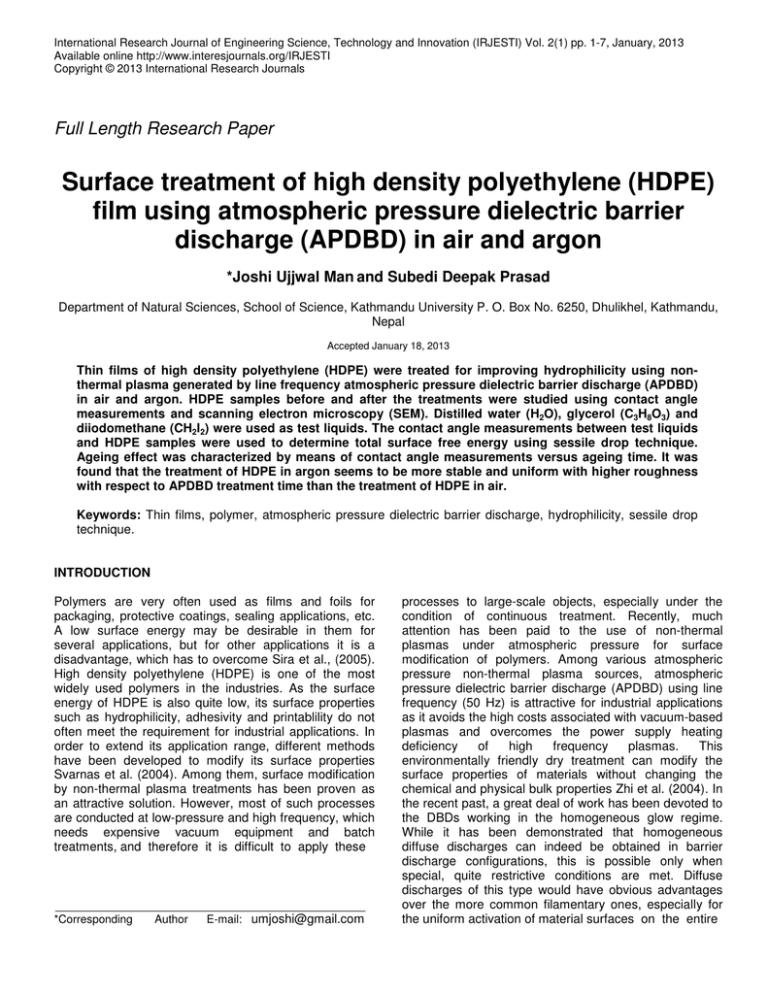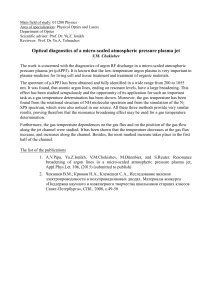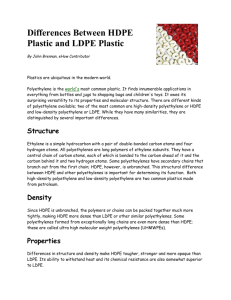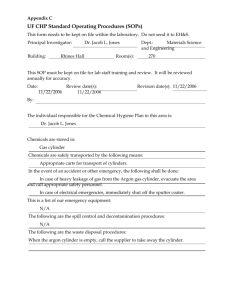Document 14104474
advertisement

International Research Journal of Engineering Science, Technology and Innovation (IRJESTI) Vol. 2(1) pp. 1-7, January, 2013 Available online http://www.interesjournals.org/IRJESTI Copyright © 2013 International Research Journals Full Length Research Paper Surface treatment of high density polyethylene (HDPE) film using atmospheric pressure dielectric barrier discharge (APDBD) in air and argon *Joshi Ujjwal Man and Subedi Deepak Prasad Department of Natural Sciences, School of Science, Kathmandu University P. O. Box No. 6250, Dhulikhel, Kathmandu, Nepal Accepted January 18, 2013 Thin films of high density polyethylene (HDPE) were treated for improving hydrophilicity using nonthermal plasma generated by line frequency atmospheric pressure dielectric barrier discharge (APDBD) in air and argon. HDPE samples before and after the treatments were studied using contact angle measurements and scanning electron microscopy (SEM). Distilled water (H2O), glycerol (C3H8O3) and diiodomethane (CH2I2) were used as test liquids. The contact angle measurements between test liquids and HDPE samples were used to determine total surface free energy using sessile drop technique. Ageing effect was characterized by means of contact angle measurements versus ageing time. It was found that the treatment of HDPE in argon seems to be more stable and uniform with higher roughness with respect to APDBD treatment time than the treatment of HDPE in air. Keywords: Thin films, polymer, atmospheric pressure dielectric barrier discharge, hydrophilicity, sessile drop technique. INTRODUCTION Polymers are very often used as films and foils for packaging, protective coatings, sealing applications, etc. A low surface energy may be desirable in them for several applications, but for other applications it is a disadvantage, which has to overcome Sira et al., (2005). High density polyethylene (HDPE) is one of the most widely used polymers in the industries. As the surface energy of HDPE is also quite low, its surface properties such as hydrophilicity, adhesivity and printablility do not often meet the requirement for industrial applications. In order to extend its application range, different methods have been developed to modify its surface properties Svarnas et al. (2004). Among them, surface modification by non-thermal plasma treatments has been proven as an attractive solution. However, most of such processes are conducted at low-pressure and high frequency, which needs expensive vacuum equipment and batch treatments, and therefore it is difficult to apply these *Corresponding Author E-mail: umjoshi@gmail.com processes to large-scale objects, especially under the condition of continuous treatment. Recently, much attention has been paid to the use of non-thermal plasmas under atmospheric pressure for surface modification of polymers. Among various atmospheric pressure non-thermal plasma sources, atmospheric pressure dielectric barrier discharge (APDBD) using line frequency (50 Hz) is attractive for industrial applications as it avoids the high costs associated with vacuum-based plasmas and overcomes the power supply heating deficiency of high frequency plasmas. This environmentally friendly dry treatment can modify the surface properties of materials without changing the chemical and physical bulk properties Zhi et al. (2004). In the recent past, a great deal of work has been devoted to the DBDs working in the homogeneous glow regime. While it has been demonstrated that homogeneous diffuse discharges can indeed be obtained in barrier discharge configurations, this is possible only when special, quite restrictive conditions are met. Diffuse discharges of this type would have obvious advantages over the more common filamentary ones, especially for the uniform activation of material surfaces on the entire 2 Int. Res. J. Eng. Sci. Technol. Innov. Figure 1. Schematic diagram of the experimental set-up. area exposed to the discharge. However, in practice, it is difficult and tricky to reliably control homogeneous glow discharges at atmospheric pressure. The filamentary DBD is an excellent source of micro discharges containing energetic electrons Borcia et al. (2003). In this study, HDPE film samples were treated in atmospheric pressure dielectric barrier discharge (APDBD) using line frequency (50 Hz) in air and argon. Surface analysis and characterization of the samples were performed using contact angle measurements, ageing effect, surface free energy and scanning electron microscopy (SEM). EXPERIMENTAL SET-UP AND PROCEDURE The general view of the experimental set-up is shown in Figure 1. For the discharge, two rectangular copper electrodes with dimensions 5 cm × 3.5 cm × 1 cm were used covering the lower electrode by a polycarbonate (PC) plate with dimensions 10 cm × 8 cm × 0.2 cm, separated by a gap, resulting in DBD. The upper electrode was fixed and the lower electrode was movable in a vertical scale to adjust the electrode gap. The discharge was generated via line frequency (50 Hz) high voltage (maximum peak-to-peak value of 50 kV) power supply connected in series to a ballast resistor. The characteristic of the discharge was sensitive to the electrode gap and the ballast resistor which affect the uniformity of the material surface treatment. According to the electrical characterization of the discharge performed in previous experiments Baral (2009) shows that the discharge was uniform with electrode gap 3.5 mm, applied voltage 15 kV and ballast resistor 20 MΩ. Thus, similar electrode gap, applied voltage and ballast resistor were used in the experiment. Commercially available high density polyethylene (HDPE) films from Good fellow Ltd., UK of thickness 0.01 mm and with dimensions 3 cm × 2.5 cm were used as samples for plasma treatment. Before the treatment, the samples were washed in propylene and then washed in distilled water, ultrasonicated for ten minutes, and dried at room temperature. HDPE samples before and after the treatment was studied using contact angle measurements and scanning electron microscopy (SEM). Static contact angle measurements were made before the treatment and immediately after the treatment by dropping 4 µl of distilled water (H2O), glycerol (C3H8O3) and diiodomethane (CH2I2) on the surface. Different liquid drops on the HDPE surface were imaged using CCD camera and the contact angles were measured using Rame hart contact angle goniometer, model: 200. The values of the static contact angle were the average of four measured values. The static contact angles between the test liquids and HDPE samples were used to determine total surface free energy using sessile drop Joshi and Subedi 3 100 Air Argon 90 Contact angle (degree) 80 70 60 50 40 30 20 10 0 0 10 20 30 40 50 60 Treatment time (s) Figure 2. Variation of water contact angle with treatment time. technique. Ageing effect was characterized by means of contact angle measurements versus ageing time. The treated films were stored in a glass box in the atmospheric air. The samples were treated using APDBD in argon with a flow rate of about 2 liters per minute. The topography of the HDPE surface before and after the treatment was investigated by using a scanning electron microscopy (SEM) (Leo 500 microscope) in ambient conditions. RESULTS AND DISCUSSION Surface treatments were performed by setting the electrode gap to 3.5 mm with applied voltage 15 kV and ballast resistor 20 MΩ. The changes in surface properties were studied by varying the treatment time. Ageing effect In cold plasma processing of polymer films, one of the most challenging problems is to achieve a long-lasting treatment effect. The change of the static water contact angle with storage time in ambient air at room temperature after 60 seconds plasma treatment is monitored for 15 days and the results are shown in Figure 3. In case of treatment in air, the values of the contact angle are seen to increase rapidly over a period of the first few hours, and then change very slowly to reach a nearly stable value of 67°, still significantly smaller than the value of untreated HDPE. But in case of treatment in argon, the values of the contact angle remain almost stable with slight variations. Surface free energy measurement Contact angle measurement Figure 2 shows the variation of the static water contact angle on the surface of the HDPE film with APDBD treatment time. It is seen that a rapid decrease in the contact angle takes place with the treatment time up to 10 seconds which shows that a strong increase of wettablility in the HDPE surface is induced by APDBD treatment. The static water contact angle observed is found to change from 92° for the untreated sample to the minimum values of about 52° after 30 seconds APDBD treatment in air and about 44° after 30 seconds APDBD treatment in argon. When the treatment time exceeds 10 seconds, the measured static contact angles seem to reach a saturation state. The contact angles between the test liquids and HDPE film were used to determine the total surface free energy using sessile drop technique and three liquid model. The 2 surface free energy of untreated HDPE is 35±2 mJ/m . The dependence of the surface free energy and its components on the treatment time for both air and argon treatment is shown in Figures 4 and 5. It can be seen from the figures that the maximum value of the surface free energy is reached after 10 s of the treatment and further treatment does not lead to significant changes in the surface free energy and its components. Surface energy measurements suggest that the enhancement in HDPE wettability is caused by the introduction of polar groups on the surface while in case of air treatment, the hydrophobic recovery can be 4 Int. Res. J. Eng. Sci. Technol. Innov. 100 Air Argon 90 Contact angle (degree) 80 70 60 50 40 30 20 10 0 0 2 4 6 8 10 12 14 16 Storage time (day) Figure 3. Variation of water contact angle with storage time in ambient air. 50 2 Surface free energy (mJ/m ) γ γ 40 LW 30 γ − 20 10 γ γ 0 0 10 20 30 40 50 ΑΒ + 60 70 Treatment time (s) Figure 4. Variation of surface free energy with treatment time (Air). γ is the surface free energy, γLW is its dispersion part and γAB is its acid–base part. γ+ is the electron–donor component and γ− is the electron–acceptor component of the acid-base interaction. imputed to the migration of those polar groups into the polymer bulk. But the movement of polar groups and the resultant increase in contact angles is quite reduced in case of argon treatment. This is because CASING (crosslinking via activated species of inert gases) occurs in polymer surfaces exposed to noble gas plasma (e.g., Ar or He) which is effective at creating free radicals but do not add new chemical functionalities from the gas phase. Ion bombardment can break C–C or C–H bonds, and the free radicals resulting under these conditions can react only with other surface radicals, therefore, they tend to be quite stable, Mittal and Pizzi (1999). SEM Analysis In order to compare the HDPE surface modifications in air and argon, the samples were treated using APDBD Joshi and Subedi 5 Surface free energy (mJ/m2) 50 γ 40 γ 30 γ LW − 20 10 γ 0 γ 0 10 20 30 40 50 60 ΑΒ + 70 Treatment time (s) Figure 5. Variation of surface free energy with treatment time (Argon). γ is the surface free energy, γLW is its dispersion part and γAB is its acid– base part. γ+ is the electron–donor component and γ− is the electron– acceptor component of the acid-base interaction. 6 Int. Res. J. Eng. Sci. Technol. Innov. Figure 6. SEM images of HDPE film surfaces before and after the plasma treatment (a) Untreated, (b) Air treated and (c) Argon treated. first in air and then in argon with a flow rate of about 2 liters per minute. The treatments were performed by setting the electrode gap to 3.5 mm with applied voltage 15 kV and ballast resistor 20 MΩ. The SEM images of untreated and treated HDPE in air and argon are shown in Figures 6. The topography of the treated HDPE Joshi and Subedi 7 appears to be different than the untreated one. It can be seen that the treatment in argon is uniform with higher roughness of the treated surface than the treatment in air. University of Warsaw, Poland for their valuable support in this research work. REFERENCES CONCLUSIONS The set of experimental results on the surface treatment of high density polyethylene (HDPE) film with atmospheric pressure dielectric barrier discharge (APDBD) using line frequency (50 Hz) both in air and argon proves that this kind of discharge is a convenient and efficient source of non-thermal plasma. Moreover, the results presented above show that HDPE treatment in APDBD resulted in the decrease of static water contact angle. The static contact angle decreases more in case of APDBD treatment of HDPE in argon than in air. The result of ageing effect in ambient air after the APDBD treatment show that the treated HDPE surface has a good stability over ageing time in case of argon treatment than in air treatment. The surface free energy of argon treated HDPE is increased than the surface free energy of air treated HDPE. Increased surface free energy leads to increased wettability. SEM analysis shows that HDPE treatment in argon is uniform with higher roughness in comparison with HDPE treatment in air. ACKNOWLEDGEMENT The authors would like to thank Prof. C. S. Wong, University of Malaya, Malaysia and Prof. Andrzej Huczko, Baral D (2009). Surface modification of low density polyethylene, M.Sc. dissertation submitted to Central Department of Physics, Tribhuvan University, Nepal. Borcia G, Anderson CA, Brown NMD (2003). Dielectric barrier discharge for surface treatment: application to selected polymers in film and fibre form. Plasma Sources Sci. Technol. 12:335. Mittal KL, Pizzi A (1999). Adhesion promotion techniques: Technological applications. Marcel Dekker, Inc., New York. Oiseth SK, Krozer A, Kasemo B, Lausmaa J (2002). Surface modification of spin-coated high-density polyethylene films by argon and oxygen glow discharge plasma treatments. Appl. Surf. Sci. 202:92-103. Sira M, Trunec D, Stahel P, Bursikova V, Navratil Z, Bursik J (2005). Surface modification of polyethylene and polypropalene in atmospheric pressure glow discharge. J. Phys. D: Appl. Phys. 38: 621. Subedi DP, Madhup DK, Adhikari K, Joshi UM (2008). Low pressure plasma treatment for the enhancement of wettability of polycarbonate. Indian Journal of Pure and Applied Physics 46:540. Svarnas P, Spyrou N, Held B (2004). Polystyrene thin films treatment under DC point-to-plane low-pressure discharge in nitrogen for improving wettability. Eur. Phys. J. Appl. Phys. 28:105. Zhi F, Yuchang Q, Hui W (2004). Surface treatment of polyethylene terephthalate film using atmospheric pressure glow discharge in air. Plasma Sci. Technol. 6:2576.



